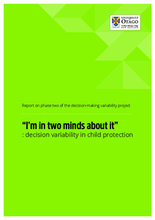INTRODUCTION
Decisions in the child protection context take place in a complex environment influenced by individual decision-makers, institutional resources and practices, demographic inequalities, and family responses. While some variation in decision outcomes are inevitable and desirable in order to respond to unique family and whānau contexts, the principles, logics and resources informing such decisions should be consistent. Where they differ too much, families in similar situations receive different responses, contributing to inequities and inconsistencies in decision outcomes. Both children and families should expect intervention in family life to be relatively consistent, so that children’s rights to protection, and family and whānau rights to autonomy are transparently and consistently balanced. Wider inequalities are a substantial cause of differences in outcomes, nevertheless, institutional and individual factors also contribute to decision variability. This report describes some of these factors as reported by practitioners in the child protection context in Aotearoa New Zealand, providing an insight into the experiences and perceptions of front-line practitioners. By describing simple and difficult cases, views of the causes of decision variability, and perceptions of what contributes to ‘good’ decisions, valuable practice-based knowledge can be accessed from practitioners’ own practice-rich perspectives. This can be utilized to inform practice development and contribute to equitable outcomes for families and whānau.

